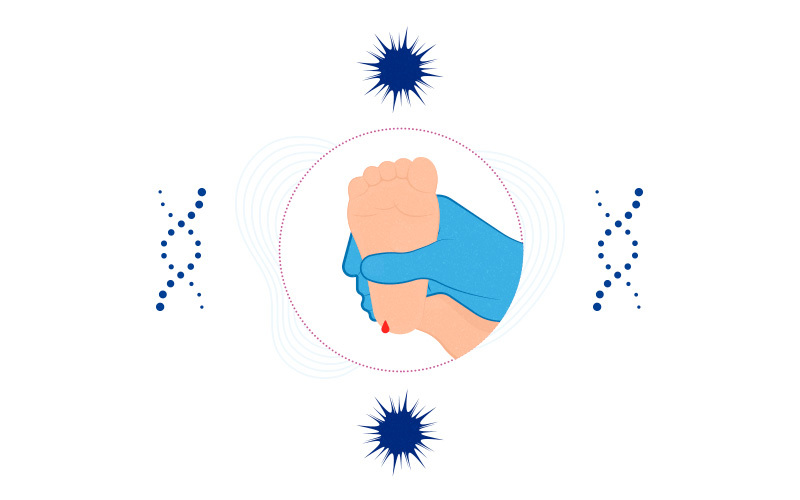Newborn genetic screening for pediatric cancer risk could save lives

Numerous genetic mutations increase children’s risk for various cancers. When they are detected early, cancers can potentially be caught at an early, more treatable stage — or avoided entirely. Could adding such “cancer predisposition” genes to routine newborn “heel-stick” screening save lives?
Lisa Diller, MD, chief medical officer at the Dana-Farber/Boston Children’s Cancer and Blood Disorders Center, thought it could. She had cared for a child with aggressive bilateral retinoblastomas who became blind due to the tumor and its necessary treatments. But the patient’s sister was found — at birth — to have the same RB1 mutation. After surveillance detected early-stage retinoblastoma, she was successfully treated with minimal local therapies — and her vision is perfect.
Another child had an aggressive pleuropulmonary blastoma and an inherited mutation in DICER1. Her younger brother, with the same mutation, had precancerous lung cysts. These were resected and he never developed cancer.
“We are seeing children like these younger siblings more frequently, from families with a known genetic risk for early cancer or with syndromes known to be associated with cancer,” says Diller, who also co-directs the Pediatric Cancer Genetic Risk Program at Dana-Farber/Boston Children’s. “But what if there isn’t a family member or syndrome to tell us to look for early cancers and precancer? From a population-based perspective, genetic testing for cancer predisposition has not really been studied.”
PreEMPTing early-onset cancers
To get answers, Diller teamed up with Jennifer M. Yeh, PhD, and Ann Chen Wu, MD, MPH, in Boston Children’s Division of General Pediatrics. Both have experience modeling complex population-level questions. Using the Precision Medicine Policy and Treatment Model (PreEMPT), they simulated the clinical and economic outcomes of newborn genetic screening for pediatric cancer predisposition syndromes.
The model incorporated a panel of 11 genes associated with early-onset solid tumors or brain tumors that all have guidelines for surveillance and preventive care. As reported last month in the journal Genetics in Medicine, adding these genes to newborn screening could potentially cut cancer deaths in half before the age of 20 among children found to have a pathogenic or likely pathogenic variant.
The 11 genes included both RB1 and DICER1, as well as RET, TP53, SUFU, PTCH1, SMARCB1, WT1, APC, ALK, and PHO2XB. Using PreEMPT, the team compared usual care (with no added genetic testing) to universal newborn testing of the 11 genes, using targeted next-generation sequencing, plus follow-up surveillance and care.
To estimate testing yields and patient outcomes, the team used data from clinical studies, the ClinVar and gnomAD genomic databases, and national cancer surveillance data.
“A randomized, controlled trial is probably the gold standard for studying screening outcomes,” says Wu, who was co-senior investigator on the study with Diller. “But it would require a long time and a very large sample size, because pediatric cancers are rare.”
Cutting mortality in half
Applied to a typical annual U.S. birth cohort of 3.7 million newborns, PreEMPT estimated the following:
- Under usual care, 1,803 newborns would develop, before the age of 20, a malignancy associated with one of the 11 cancer predisposition genes. Of these, 13 percent would be expected to have a pathogenic or likely pathogenic variant detected in one of those genes.
- Under universal genetic screening, 1,584 newborns would be identified as having a pathogenic/likely pathogenic variant in one of the genes. Of these newborns, 232 (about 1 in 7) would develop a malignancy by age 20.
- Among children with a cancer risk variant found on newborn screening, subsequent surveillance and care would reduce cancer deaths before age 20 by half as compared with no screening/usual care.
- In the overall cohort (children with and without cancer-associated variants), newborn testing and surveillance would reduce cancer deaths by 7.8 percent.
The researchers next considered the costs of universal newborn screening of the 11 genes in the context of other public health interventions, incorporating the costs saved by catching cancers early or before they start. Assuming that clinicians followed recommended cancer screening guidelines, they calculated that the cost per year of life gained with the added genetic testing would be $244,860 with a test costing $55. But the costs of genetic screening are declining. A $20 test would bring the cost down to $99,430 per life-year, which would be cost-effective relative to common benchmarks.
“In the U.S., a cost of $100,000 per life-year gained is generally considered ‘good value for resources invested,’” says Yeh, first author on the study, “although higher thresholds have been suggested for rare diseases like childhood cancers.”
Future directions
The researchers acknowledge potential downsides of universal newborn screening. Some children would undergo surveillance and testing that turn out to be unnecessary. Families would have to live with anxiety about the future. The team plans to refine its model, incorporating more real-world data, more precise information on genetic variants’ likelihood of causing disease, and the potential impact of early detection and follow-up.
“Some newborns may carry a pathogenic variant and never develop cancer,” Yeh acknowledges. “A strength of our modeling approach was to estimate the number of variant carriers that would need to be followed for the benefits associated with surveillance to be realized. As better data becomes available, we can provide updated estimates.”
Future models would also include other potential benefits of newborn screening, such as early detection of adult-onset cancers, detection of cancer risk in family members, and family reproductive planning.
In the meantime, Diller has developed a web-based tool called the SKAN (Surveillance in Kids At Risk for Neoplasia) Planner for use by oncology professionals, primary care providers, geneticists, and genetic counselors, to be released later this year. It will provide age- and syndrome-specific surveillance recommendations for children with cancer predisposition syndromes.
Learn more about our Pediatric Cancer Genetic Risk Program.
Related Posts :
-

New research sheds light on the genetic roots of amblyopia
For decades, amblyopia has been considered a disorder primarily caused by abnormal visual experiences early in life. But new research ...
-

Parsing the promise of inosine for neurogenic bladder
Spinal cord damage — whether from traumatic injury or conditions such as spina bifida — can have a profound impact on bladder ...
-

Thanks to Carter and his family, people are talking about spastic paraplegia
Nine-year-old Carter may be the most devoted — and popular — sports fan in his Connecticut town. “He loves all sports,” ...
-

“A setback for a comeback”: Brody perseveres with Paget-Schroetter Syndrome
Baseball has been part of Brody Walsh’s story from the very start. Now 19 and a college sophomore, Brody pitches ...





